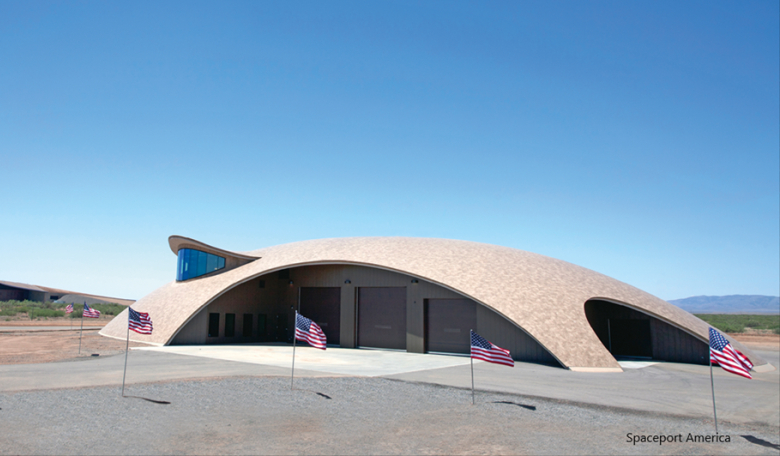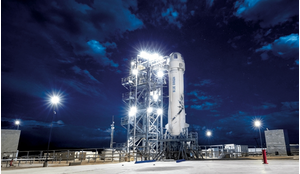Spaceport America boasts some impressive credentials, not least the fact that it was the first purpose-built commercial spaceport in the world. The FAA-licensed launch complex, situated on 18,000 acres adjacent to the US Army White Sands Missile Range in southern New Mexico, has a rocket-friendly environment, access to 6000 square miles of restricted airspace, low population density, a 3658 m x 61 m runway, a vertical launch area, and it averages about 340 days of sunshine and low humidity. ROOM Editor-in-Chief Clive Simpson met up with Scott McLaughlin, Spaceport America’s Executive Director, at this year’s Space Symposium in Colorado Springs.
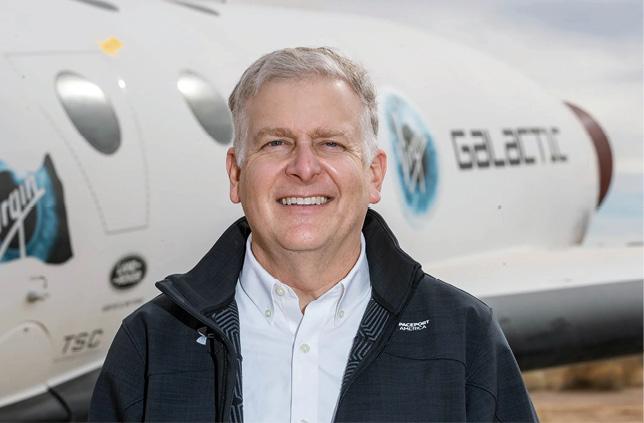 Scott McLaughlin pictured in front of a replica of the Virgin Galactic spacecraft VSS Unity near the spaceport entrance.
Scott McLaughlin pictured in front of a replica of the Virgin Galactic spacecraft VSS Unity near the spaceport entrance.
What is the background to Spaceport America and how did it come into being?
It was funded by the state of New Mexico with the plan of creating a multi-function base for space operations, for more than just its famous customer, Virgin Galactic. After receiving legislative approval in 2006, the ‘Southwest Regional Spaceport’, later renamed Spaceport America, was little more than a separate area for vertical launches by UP Aerospace, a sub-orbital transportation corporation.
Spaceport America lies in a vast desert valley in southern New Mexico, to the east of Truth or Consequences off the I-25 highway. The desert basin is named the Jornada Del Muerto, after a wagon route from the days of the Camino Real de Tierra Adentro. This silver route connected Mexico City, more than 2500 km, to the San Juan Pueblo in northern New Mexico, almost five hundred years ago.
Just 50 km north of the basin is the Trinity Site, where Oppenheimer’s Manhattan project came to fruition with the first atomic bomb test in 1945. Over a range of desert mountains on the eastern horizon lies the US Army White Sands Missile Range, a large military test site which provides the Spaceport with some services and airspace protections.
Our goal is to become a premier multi-modal spaceport for point–to-point space transportation, space tourism, aerospace operations, research development and testing
The iconic terminal hangar facility was designed by London-based architectural firm Foster + Partners with emphasis on a one-of-a-kind design and minimal environmental impact. Looking low and organic from a distance, with concrete and self-protecting rust-layer steel walls, up-close the facility has the appearance of a bunker. The spaceport’s main structure was built between 2009 and 2014, with the interior only completed in 2018 by our foundational customer, Virgin Galactic (VG).
Initially, VG suffered significant delays, with some test flights moving to the Spaceport in 2020. Richard Branson finally made his journey to space in July 2021, complete with memorable promo shots of him arriving at Spaceport America on a bicycle.
Virgin Galactic’s involvement in space tourism, and its mission to democratise space, has been progressing to regular launches out of Spaceport. Last year they achieved seven launches.
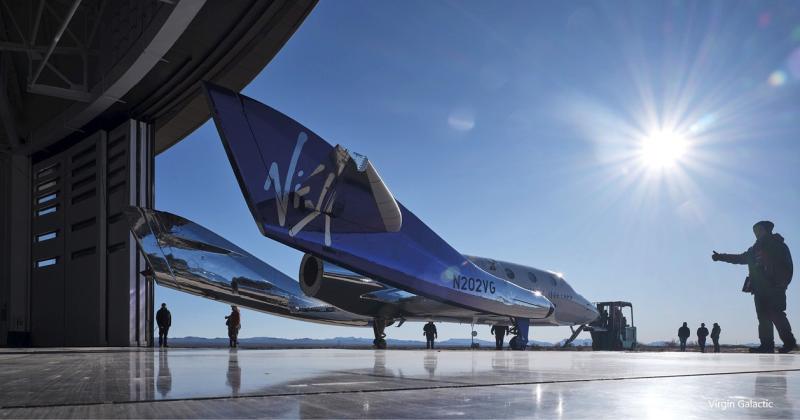 VSS Unity in the hanger at Spaceport America.
VSS Unity in the hanger at Spaceport America.
What is your vision and how does the future look?
Our goal is to become a premier multi-modal orbital spaceport for point-to-point space transportation, space tourism, aerospace operations, research development and testing.
As a spaceport, we have had horizontal launch and vertical launch licences right from the beginning. We’re in a remote area on 18,000 acres of land so we’ve been able to develop three distinct areas – the horizontal launch area (HLA), vertical launch area (VLA), and an advanced technology area (ATA).
In the latter we have SpinLaunch, a company that’s working on a centrifuge, kinetic energy option for the first stage. In the VLA we have UP Aerospace, and small drone developments. In the HLA we have Virgin Galactic, of course, plus a growing infrastructure which includes a satellite ground station.
We’re also hosting high altitude platform systems, sometimes called High Altitude Pseudo-Satellites, which are usually large unmanned aerial vehicles (UAV) that are designed to fly at heights of between 60,000 and 80,000 feet. These systems are solar powered and can hover over a large area for a long time with the goal of being up there for six months at a time. Here at Spaceport, they’re doing a lot of testing and are working to become FAA (Federal Aviation Authority) certified.
UAVs are going to prove to be very useful in terms of relieving the strain on crowded low Earth orbits [LEO] or if satellites are damaged or destroyed in war. High altitude platforms Systems [HAPS] would be able to supply precision navigation and timing, as well as surveillance and communications services.
We have three companies working on these:
- AeroVironment is the largest HAPS system, it’s 261 feet, almost as big as a football field, eight feet wide, and covered in solar panels
- BAE Systems, Inc. operates Prismatic, a company that is doing the same thing, just on a smaller scale.
- Swift Engineering, which has an even smaller version of the systems.
What makes your site in New Mexico so attractive?
Space tourism has a big future and we’re excited about this
One of our essential selling points is that we are in a remote location, north of Las Cruces, New Mexico, and we’re under the restricted airspace of White Sands Missile Range. We have an agreement with White Sands Missile Range - we work with them and the FAA to authorise our launches, as well as being able to host vehicles like HAPS that otherwise would be difficult to fly in traditional FAA airspace.
But being remote means we are responsible for suppling our own security, fire and emergency services. These resources are on standby 24/7 and are one of our largest ongoing expenses. Some funding is contributed by the State of New Mexico to run our operations, but we also generate cashflow from our customers. In total, our annual budget is around US $11 million.
We’re always looking for new customers, including launch providers who could use our airspace to do testing. We have hosted liquid engines, rocket engine testing, and solid rocket motor manufacturing out there.
Our concrete runway is 12,000 feet by 200 feet, so we can host other types of vehicles, including racecars that lease the space for a time. But our future is focused on orbital launch, maybe in about 10 to 15 years from now.
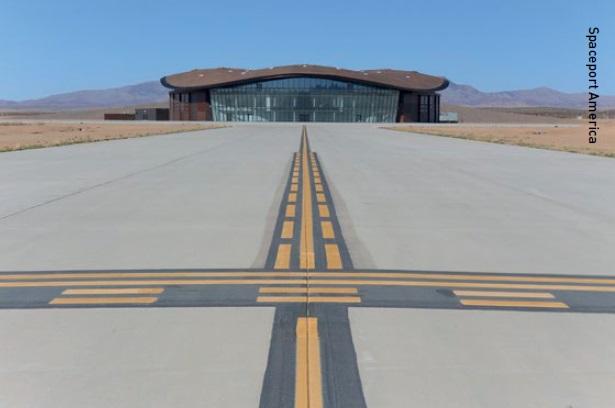 Facade of the Gateway to Space, used by Virgin Galactic.
Facade of the Gateway to Space, used by Virgin Galactic.
How is the future shaping up?
Right now, vertical vehicles are not space-certified and reliable enough, at least under the FAA standards, to overfly human populations. However, I don’t see a reason why in 10 years or so, 10 to 15 years, the vehicles will be safer and will have better safety systems, giving us the ability to host orbital launches.
We’ve also been talking to a few of the horizontal launch developers who are working on winged systems, which have better safety features. In these launches, if the craft cannot make it to orbit, it can glide back down and land.
Virgin Galactic is building new spaceships and will build a new carrier aircraft and their goal is somewhere between 300 and 400 launches a year at the Spaceport. That’s going to be a launch every day, sometimes twice a day. They, and others, have discussed working on point-to-point development, so one could fly from one spaceport to another, but I imagine it will be a few more years before this happens. So in the meantime, we’re going to be working alongside Virgin Galactic on its suborbital space tourism system.
Following this year’s most recent flight, they are concentrating on two new spaceships they’re building in Arizona, which we expect to show up in about 14 months at Spaceport. At that point, they’ll re-qualify them and ramp missions up from there. Space tourism has a big future and we’re excited about this.
Spaceport America was built by the State of New Mexico for economic development and, like most of the people that work here, I am a ‘space nerd’. But our goal really is jobs and economic impact in the area. So, when Virgin Galactic starts launching regularly, we’ll see a lot more economic impact.
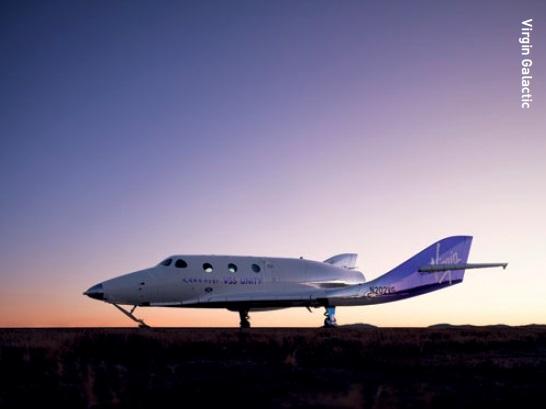 VSS Unity at Spaceport America.
VSS Unity at Spaceport America.
In more general terms, how do you see the space industry developing?
I look at it as something akin to the dot-com boom which is happening all over again but this time in space
Well, everybody is seeing the number of launches continue to go up, and the number of satellites in orbit increase. I think there are four space stations in development and we are heading back to the Moon, so one of the things that we’re looking at in terms of Spaceport America is the capacity to support things like space cargo, solar panels in space, water supplies, and eventually a growing number of people too. If we ever get to lunar or asteroid mining, we’ll need a way to bring materials back to Earth so we are working on re-entry license right now. I think we’ll be the only spaceport with vertical, horizontal and a re-entry license, which will place us in a unique position among commercial spaceports.
We expect to have the re-entry licence by the end of 2024. We also signed a memorandum of understanding with Sierra Space a few years back, and while they’re in the early stage of their first vehicle, they will develop more vehicles and get more practiced with the launches and recoveries. We’re very excited about the future we hope to have with them. Really, we’re hoping to be a bustling and busy spaceport offering excellent facilities and a first-class experience.
We have a good foundation, and the state is still supporting us in terms of infrastructure development, so we’re going to be building a new hanger later this year as well as a reception centre where we can host events or large meetings and offer a ‘mission control’ facility and payload processing. So, we do have a good foundation and we’re trying to build on it. The space market is growing very, very quickly and I look at it as something akin to the dot-com boom which is happening all over again - but this time in space.
About the interviewee
Scott A McLaughlin, a graduate of New Mexico State University with a Bachelor of Science in Electrical Engineering, is a highly experienced engineer and executive with a diverse background in both design and business. He has worked in both the private and government sectors and has travelled around the world installing, maintaining, and marketing specialised wind radar systems. His innovative designs support space launches, test ranges, aviation operations, weather service networks, atmospheric research, pollution studies, and shipboard-based wind measurements. Users include research and defence agencies such as NASA, NOAA, DOE, U.S. Army, US Navy, U.S. Air Force, universities, as well as customers across the world. He was appointed executive director of Spaceport America in March 2021.





